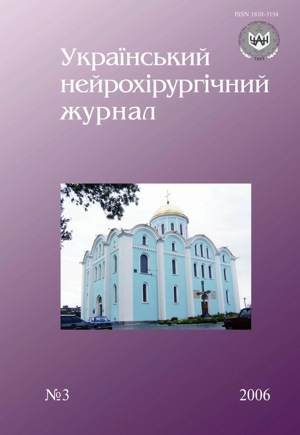The parameters of life quality in patients with intracranial aneurysms rupture in the long-term period
DOI:
https://doi.org/10.25305/unj.127811Keywords:
aneurysmal intracranial hemorrhage, late effects, quality of lifeAbstract
The mood and the life quality in patients with intracranial aneurysms rupture in the long-term period was assessed by using Hospital Anxiety and Depression Scale and the SF-36 questionnaire. The high rates of depression and anxiety disorders were revealed. The quality of life was significantly decreased in the role of physical functioning domain and emotional functioning domain.
References
Белоусова О.Б., Филатов Ю.М., Буклина С.Б. и др. Катамнез больных, оперированных в острой стадии разрыва артериальных аневризм // Вопр. нейрохирургии им. Н.Н. Бурденко. — 2003. — №3. — С.8–14.
Голік В.А. Церебральна гемодинаміка у хворих з аневризматичними субарахноїдальними крововиливами // Укр. вісн. психоневрології. — 2003. — Т.11, вип. 1 (34).
Крылов В.В. Нетравматическое субарахноидальное кровоизлияние // Неврол. журн. — 1999. — №4. — С.4–10.
Кудряшова И.В. Ранняя диагностика хронического панкреатита с позиции использования ультразвуковой томографии и индекса качества жизни: Метод. рекомендации. — Смоленск: СГМА, 2003. — С.8–14.
Лебедев В.В., Крылов В.В. Шелковский В.В. Хирургия аневризм головного мозга в остром периоде кровоизлияния. — М.: Медицина, 1996. — С.62–74.
Новик А.А., Ионова Т.И. Руководство по исследованию качества жизни в медицине. – СПб; М.: Изд. Дом «Нева»; «ОЛМА-ПРЕСС Звездный мир», 2002. — 320 с.
Сыропятов О.Г., Дзеружинская Н.А., Астапов Ю.Н., Иванцова Г.В. Ранняя диагностика и лечение депрессии в общей медицинской практике (Гелариум-тест). — К., 2003.
Berinstain X., Gaviria M., Dujony M. et al. Evaluation of outcome after intracranial aneurysm surgery: the neuropsychiatric approach // Surg. Neurol. — 1996. — V.45, N5. — P.422–429.
Buchanan K.M., Elias L.J., Goplen G.B. Differing perspectives on outcome after subarachnoid haemorrhage: the patient, the relative, the neurosurgeon // Neurosurgery. — 2000. — V.46, N4. — P.831–838.
Chiang V., Claus E., Awad I. Toward more rational prediction of outcome in patients with high-grade subarachnoid hemorrhage // Neurosurgery. — 2000. — V.46, N1. — P.28–36.
Hackett M.L, Anderson C.S. Health outcomes 1 year after subarachnoid hemorrhage // Neurology. — 2000. — V.55, N5. — P.658–662.
Ingall T., Asplund K., Mдhцnen M., Bonita R. A multinational comparison of subarachnoid hemorrhage epidemiology in the WHO MONICA Stroke Study // Stroke. — 2000. — V.31. — P.1054–1061.
Jennett B., Bond M. Assessment of outcome after severe brain damage // Lancet. — 1975. — V.1. — P.480–484.
Mangold R., Wallenfang T. Posttraumatic neuropsychological and psychiatric disorders after subarachnoid haemorrhage // Nervenheilkunde. —2000. — Bd.9. — S.32–37.
Powell J., Kitchen N., Heslin J., Greenwood R. Psychosocial outcomes at three and nine months after good neurological recovery from aneurysmal subarachnoid haemorrhage: predictors and prognosis // JNNP. — 2002. — V.72, N6. — P.772–781.
Ware J.E., Sherbourne C.D. The MOS 36-Item short-form health survey (SF-36): conceptual framework and item selection // Med. Care. — 1992. — V.30, N6. — P.473–483.
Ware J.E., Kosinski M., Gandek B. SF-36® Health Survey: Manual & Interpretation Guide. — Lincoln, RI: QualityMetric Incorporated, 2005. — 312 p.
Zigmond A.S., Snaith R.P. The Hospital Anxiety and Depression Scale // Acta Psychiatr. Scand. — 1983. — V.67, N6. — P.361–370.
Downloads
How to Cite
Issue
Section
License
Copyright (c) 2006 A. S. Son, V. N. Hertsev

This work is licensed under a Creative Commons Attribution 4.0 International License.
Ukrainian Neurosurgical Journal abides by the CREATIVE COMMONS copyright rights and permissions for open access journals.
Authors, who are published in this Journal, agree to the following conditions:
1. The authors reserve the right to authorship of the work and pass the first publication right of this work to the Journal under the terms of Creative Commons Attribution License, which allows others to freely distribute the published research with the obligatory reference to the authors of the original work and the first publication of the work in this Journal.
2. The authors have the right to conclude separate supplement agreements that relate to non-exclusive work distribution in the form of which it has been published by the Journal (for example, to upload the work to the online storage of the Journal or publish it as part of a monograph), provided that the reference to the first publication of the work in this Journal is included.









